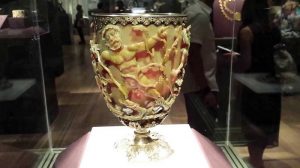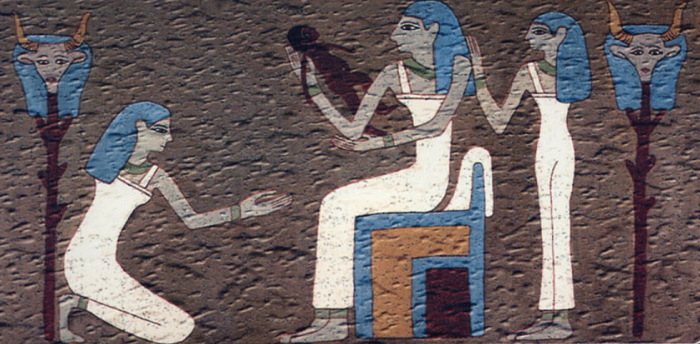The mystery of the Roman Lycurgus Cup: Nanotechnology in the ancient world?
 The British Museum holds a very beautiful ancient exhibit – the Roman Lycurgus Cup. But he is more famous for his unusual optical properties. Under normal lighting, the goblet appears yellowish-green, and in transmitted light it acquires a deep wine-red hue. Only in 1990, scientists were able to reveal the secret of these unique properties, but how could such an effect be achieved in ancient times? After all, these are the real nanotechnologies …
The British Museum holds a very beautiful ancient exhibit – the Roman Lycurgus Cup. But he is more famous for his unusual optical properties. Under normal lighting, the goblet appears yellowish-green, and in transmitted light it acquires a deep wine-red hue. Only in 1990, scientists were able to reveal the secret of these unique properties, but how could such an effect be achieved in ancient times? After all, these are the real nanotechnologies …
The cup is a so-called diatret – a double-walled bell covered with a figured pattern. Its height is 16.5, and its diameter is 13.2 centimeters.
The earliest found diatrets belong to the 1st century BC. n e., and their heyday reached its production in the III and IV centuries. Diatrets in that era were considered very expensive items and were available only to the rich. To date, they found about 50 pieces, and mostly only in the form of fragments. The Lycurgus Cup is the only diatreta that is so well preserved.
Presumably, this amazingly beautiful cup was made in the 4th century in Alexandria or Rome. But to date products made from inorganic materials is very difficult, and it may well turn out to be much more ancient than it is supposed at the moment. The place of its manufacture is also indicated very presumably, while proceeding from the fact that the glass-blowing craft flourished here in ancient times.
Experts did not reach a consensus regarding the purpose of this cup. Based on its shape, many consider it a drinking vessel. And taking into account the fact that the color of the cup also changes depending on the liquid poured into it, it can be assumed that it was used to determine the quality of the wine, or to find out whether poison was poured into drinks.
There is another version regarding the use of diatret. A peculiar edge on some surviving specimens, as well as a bronze ring on one of them, testify in favor of the fact that they could be used as fixtures.
It is also unknown how this cup was among the treasures of the Roman Catholic Church, who found it, where and when. In the 18th century, it fell into the hands of the French revolutionaries, who later, very much in need of money, sold it. Someone, apparently for preservation, attached a base and a bezel of gilded bronze to it.
In 1845, the banker Lionel de Rothschild bought the artifact for his collection, and 12 years later he caught the eye of German art historian Gustav Vaagen. Struck by the beauty and unusual properties of the cup, Vahagen began to persuade the banker to show this treasure to the general public. Finally, he agreed, and in 1862 the cup as an exhibit was exhibited for a while at the Victoria and Albert Museum in London.
After that, the cup again for almost a century was in a private collection. But the researchers did not forget about him. In 1950, the owner of the Cup, Victor Rothschild, one of the descendants of the banker, allowed a group of scientists to take him for a while to study. It was then that it turned out that the cup was not at all metallic, as it had been supposed before, but made of glass, but not ordinary, but containing layers of impurities of metal oxides (dichroic glass). In 1958, giving in to numerous requests, Rothschild nevertheless did a good deed and sold the cup to the British Museum.
Why diatret called Lycurgus Cup
The plot of the high relief on the surface of the bowl reminds one of the famous myths of the ancient world about Tsar Lycurgus.
Being an ardent opponent of libations and Bacchus and orgies, arranged by the god of winemaking Dionysus in the company of companions-menad, Lycurgus once, unable to bear it, beat them and drove them out of its territory.
Insulted Dionysus decided to take revenge on the king for this and sent him one of his most sultry beauties, the nymph Ambrose, who enchanted and drunk Lycurgus. The drunken king fell into a frenzy, rushed to cut down the vineyard, and in a frenzy cut down his mother and son.
Then Dionysus with satyrs entangled the king, turning into grape stalks. Trying to get rid of them, Lycurgus, instead of a vine, accidentally cut off his leg and soon died from blood loss.
After the cup was handed over to the museum, scientists had more opportunities to study it. But, nevertheless, for a long time they could not reveal the secret of its unusual optical properties. Only in 1990, using an electron microscope, they finally guessed that it was all about the special composition of the glass from which it was made. A million particles of this glass accounted for three hundred and thirty particles of silver and forty gold. Moreover, the silver and gold contained in the glass had the size of nanoparticles.



